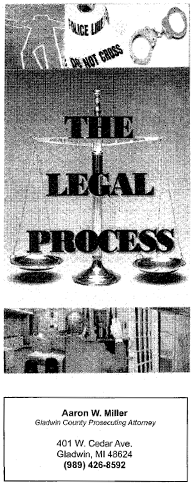prosecuting attorney – steps in a criminal case

Steps in a Criminal Case
The Legal Process
The following is a brief outline of how a case progresses through he criminal justice system. (Italicized words are defined in the Definitions Section below. Bolded words are rights provided by Crime Victim’s Act enacted in 1988).
MISDEMEANOR CASE
- After an investigation, the police either: (a) make a report and keep it on file; or (b) fill out a complaint / warrant request and submit it, and their report to the Prosecuting Attorney for review.
- When the Prosecuting Attorney reviews the complaint, he / she may (a) authorize charges; (b) deny charges due to lack of evidence to prove that a crime was committed or identity of who committed the crime; or (c) return it to the police for further investigation and resubmission.
- If the Prosecuting authorizes charges: (a) a warrant is issued by the District Court, and the police attempt to arrest the suspect; (b) Victim’s Rights information is mailed to the victim.
- Once arrested, the defendant is arraigned on the charges in District Court. At the arraignment, the defendant may plead not guilty, guilty, or no contest. If the judge accepts the defendant’s guilty or no contest plea, a sentencing date is set.
- If the defendant pleads NOT guilty, a pretrial conference is scheduled. If the pretrial conference does not resolve the case with a plea or otherwise, the case is set for either a bench trial or a jury trial. If convicted, the judge sentences the defendant.
- The probation department sometimes prepares a pre-sentence report with a sentence recommendation. Later the judge imposes a sentence at a hearing in the courtroom based on information provided by the probation department, the prosecutor, victim and defendant, the case facts, the defendant’s criminal history, and the limits imposed by the Legislature.
Felony Case
The process is the same as misdemeanor case items 1-4, except that the defendant does not enter a plea at the District Court Arraignment. In a felony case, once the defendant has been arraigned, a preliminary examination is set within 14 days of the arraignment.
- A defendant, with the Prosecuting Attorney’s consent, may waive a Preliminary Exam and be bound over to Circuit Court without an evidentiary hearing. If the defendant or the prosecutor wants the preliminary exam, a hearing is held and testimony is taken. The Prosecuting Attorney has the burden of providing that there is probable cause to believe that the crime charged was committed and that the defendant committed it. If the judge decides that the burden has been met, the case is bound over to Circuit Court.
- The defendant is arraigned on the charges in Circuit Court and may plead not guilty, guilty, or no contest.
- If the defendant pleads not guilty, the case is set for a pretrial or status conference with the defense attorney and the Prosecuting Attorney. If a plea agreement is reached and a guilty or no-contest plea is entered, then a case is sent to the probation department for a pre-sentence investigation and recommendation, and sentencing is set for a later date. If the case cannot be resolved at this time, it proceeds to trial.
- If the case is set for trial, you will receive a subpoena, and should appear as scheduled, prepared to testify. The trial prosecutor will probably meet you before the trial date to preview your testimony and prepare you for your role as a witness.
- If the case goes to trial, the judge or jury listens to the evidence and then decides whether the Prosecuting Attorney has proven beyond a reasonable doubt that the defendant committed the crime(s) charged. If the defendant is found not guilty, the defendant cannot be retried for the same crime, and is acquitted. If the jury (or judge in a bench trial) finds the defendant guilty, the case is sent to Circuit Court Probation for a pre-sentence investigation and recommendation.
- A probation agent reviews the case, the defendant’s background, and the victim’s impact statement, ten makes a written recommendation to the judge regarding as to an appropriate sentence (including restitution).
- The judge imposes the sentence at a hearing in the courtroom. The prosecutor, victim, defendant and his / her attorney may comment to the court on matters they believe are important regarding the sentencing. The victim is offered an opportunity to speak about the impact the crime has had on him / her life. Both the Prosecuting Attorney and the defense attorney will address the judge with an concerns / objections they have with the probation department’s sentencing recommendations. The defendant has the opportunity to personally address the court. The judge must weigh the probation department’s information and any other information received by the prosecutor, victim and defendant, the case facts, the defendant’s criminal history, and limits imposed by the Legislature, including the felony sentencing guidelines, when imposing an appropriate sentence.
- The defendant has the right to appeal a trial-based conviction, and may have right to appeal the sentence; however, the sentence is often carried out while he / she goes through the appeal process.
Definitions
ADJOURNMENT
Postponement until a later date, at the defendant’s, judge’s, or Prosecuting Attorney’s request. Adjournments happen for many reasons: witnesses, attorneys or defendants have scheduling conflicts or are ill; an older case may be heard that day; necessary motions or legal issues have not been decided, etc.
ADVOCATE
A person who assists the victim with support, information, resources, etc.
APPEAL
The process of having a higher court review the lower court’s decisions and / or rulings.
ARRAIGNMENT
The defendant is brought before the court and read the charges against him / her. The defendant may be asked to plead guilty, not guilty, or no contest. Bond may be set.
AUTHORIZE
The Prosecuting Attorney’s decision to issue a criminal charge.
BAIL OR BOND
The purpose of bail or bond is to insure the defendant’s appearance for future court appearances, and to enhance public safety. Bail is generally an amount of money and / or conditions of release set by the court (e.g., no contact with victim).
BENCH TRIAL
Trial before a judge, without a jury.
COMPLAINT
The written document that states the criminal charges.
DEFENDANT
The person charged with the crime.
FELONY CASE
A crime for which a person may be sent to prison for more than one year.
MISDEMEANOR CASE
A crime for which a person may be sentenced to not more than one year in jail.
MOTION
Request for a certain ruling or decision on an issue related to a case.
NO CONTEST
A type of plea is used when the defendant cannot recall his criminal actions or may be sued civilly for his / her criminal conduct. Generally the police report, rather than the defendant’s verbal admissions to the judge make up the factual basis for the plea. The defendant is treated by a sentencing judge the same as if he was convicted via a guilty plea or trial verdict.
PERJURY
A deliberate lie or untruth regarding a material fact made under oath.
PLEA
The defendant’s response to a criminal charge (guilty, not guilty or no contest).
PLEA BARGAIN
An agreement between parties for the defendant to plead guilty or no-contest under certain terms and conditions (reducing / dismissing charge(s), agreeing to terms of sentence, etc.), subject to the judge’s approval.
PRELIMINARY EXAM
A District Court hearing in felony cases to determine if there is probable cause to believe that a felony has been committed and that the defendant committed the crime.
PRE-SENTENCE INVESTIGATION
A probation department’s review of a convicted offender’s personal and criminal background. The victim is also consulted on the impact the crime has had upon his / her life and what the victim feels the sentence should include. A report is prepared and read by the judge before sentencing.
PRETRIAL CONFERENCE
An informal meeting between the Prosecutor and defendant or his / her attorney to resolve the case.
PROBATION
A sentence where a defendant’s life activities are supervised by the court.
PROSECUTING ATTORNEY
Attorney who represents the People of the State of Michigan against a criminal defendant.
RESTITUTION
An amount of money, determined by the court, to be paid to a crime victim for property loss or injuries caused by the defendant’s criminal acts. Michigan crime victims have both constitutional and statutory rights to restitution.
SUBPOENA
A court order directing a person to be present at a time and place for a court hearing.
VICTIM
A person or entity who suffers direct physical, financial and / or emotional harm, or is threatened as a result of the commission of a crime.
WAIVE
To give up a right.
WARRANT
A court’s written order commanding police to bring a person before the court.
Steps in a Criminal Case
1 – A crime is reported.
2 – The police become involved.
- An investigation takes place.
- A report is prepared.
- The report is forwarded to the prosecutor.
3 – The prosecutor become involved and has three options:
- File a criminal complaint.
- Request further investigation.
- Decline prosecution.
Should a criminal complaint be filed, it will be either a misdemeanor or a felony and go thru the following steps:
Misdemeanor
4 – Arraignment – District Court.
5 – Pre-Trial Conference.
6 – Motions.
7 – Plea or Trial.
8 – Sentencing.
Felony
4 – Arraignment – District Court.
5 – Preliminary Examination.
6 – Bind over to Circuit Court.
7 – Arraignment – Circuit Court.
8 – Pre-Trial Conference.
9 – Motions.
10 – Plea or Trial.
11 – Sentencing.

